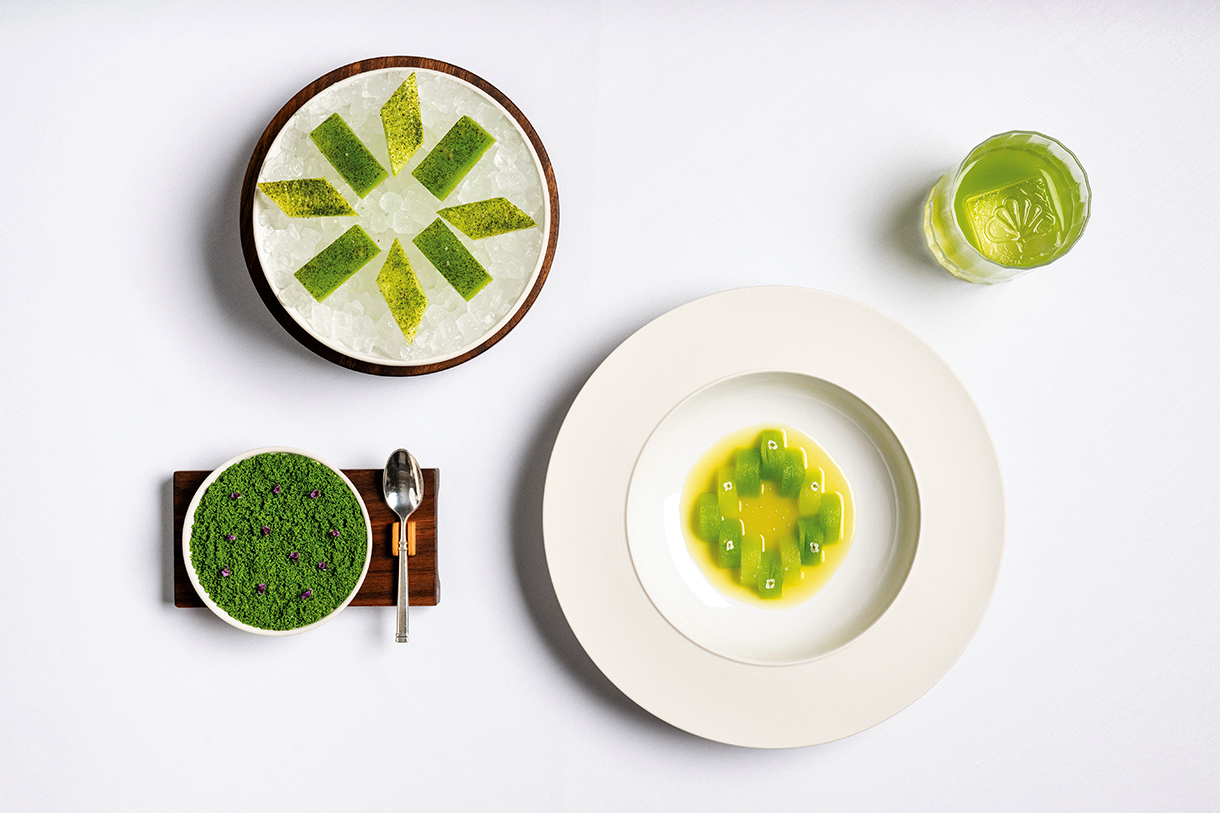
Redefining Fine Dining with Plant-based Cuisine
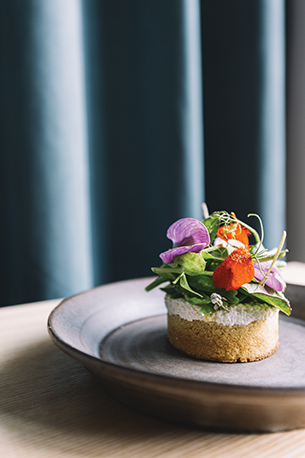
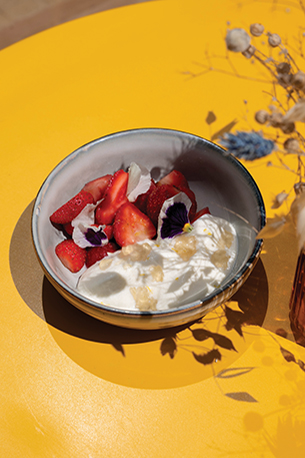
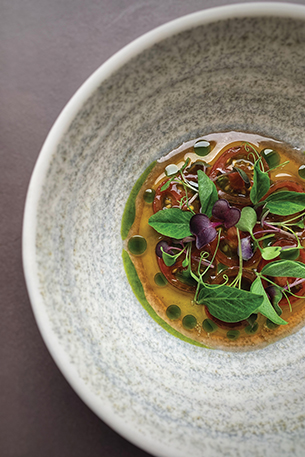
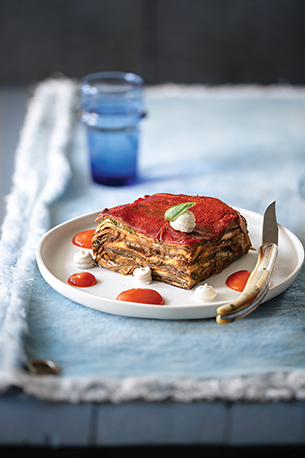
When Chef Daniel Humm was 10 years old, his parents took him to the Musée de l’Orangerie in Paris to see Claude Monet’s Water Lilies. Since 1927, the museum has housed eight of the artist’s massive oil-on-canvas panels that, at the time of their creation, were seen as something quite radical. The paint didn’t always reach the very edge of the canvas; the compositions were landscapes without the sky overtly depicted in them. “I cried,” Humm says of the experience. “I didn’t know if I was happy or I was sad, but it deeply moved me.”
Art as a language that can mine the depths of another person’s emotional landscape has been enmeshed in Humm’s 20-plus-year career as a chef. At Eleven Madison Park, the Manhattan restaurant rated with three Michelin stars for more than a decade, Humm made a name for himself by inventing emotionally provoking haute cuisine experiences. In a 2015 four-star New York Times review, critic Pete Wells wrote: “I decided to imagine that the fondue came straight out of Mr. Humm’s upbringing in Switzerland, because it worked on my senses with the deep, soulful pull of a childhood memory.”
The restaurant’s eight-course dinner menu, featuring dishes such as caviar Benedict and butternut squash with bone marrow, earned him the coveted No. 1 ranking on the 2017 World’s 50 Best Restaurants list. His work both epitomized and shaped the fine dining world’s perception of luxury itself.
“I wanted to win awards, I wanted to be the best,” Humm says. And yet at the top of the mountain, what he felt was lost. “Everyone kept asking, ‘Now what?’ And the question became problematic for me because I didn’t have an answer.” By March 2020, he didn’t have answers and he didn’t have money. With $3 million in debt and on the verge of bankruptcy amid the pandemic, Humm turned Eleven Madison Park into a community kitchen and began delivering meals to people in need. For 18 months, he got an up-close look at food insecurity and, in the process, began thinking creatively about Eleven Madison Park for the first time in years. “I knew that I had no interest in reopening the same restaurant,” he says. “I had changed, and the world didn’t need a new version of a butter-poached lobster.” It was time to tell an emotional food story with cucumber, melon, and smoked daikon.
When Humm reopened Eleven Madison Park (elevenmadisonpark.com) in June 2021, he did so with the somewhat radical declaration that the restaurant would be solely and exclusively vegan—a delineator associated more with tofu, avocado, and nut-based “cheeses” than fine dining.
“People have been cooking plant-based food for thousands of years. That’s not a new idea. But it is a new idea in a Michelin-star environment,” Humm says. “It challenges our idea of luxury. ‘What is luxury?’ Does a meal need caviar and Kobe beef to be luxurious? Or are these things old ideas and they’re actually flawed in a way that has to be recreated?”
Two months after Humm’s announcement, Chef Alain Ducasse, who has earned 21 Michelin stars over the course of his career, opened Sapid (sapid.fr)—an eatery in Paris where 95 percent of the French cuisine served is reimagined with vegetables. In a country synonymous with cream sauces, butter, foie gras, and veal, Sapid uses animal products strictly as seasoning.
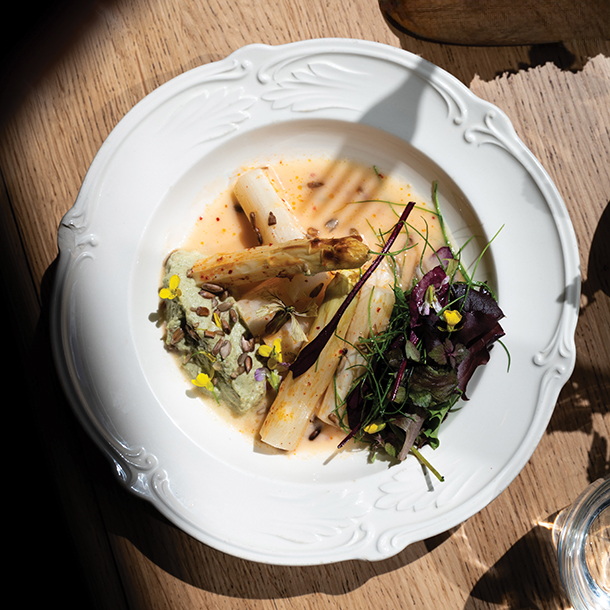
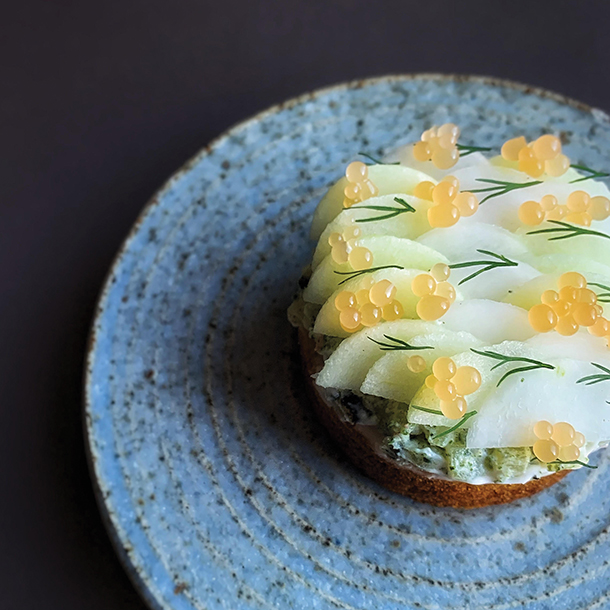
“A plant-based recipe demands probably more work to exhilarate its subtlety,” says Ducasse, who has been a proponent of plant-based cuisine for decades. In the mid-1980s, when he was entrusted with the reins of Le Louis XV in Monaco, Ducasse created an entirely vegetarian menu called Les Jardins de Provence that still exists today. There’s one difference: “We sell five times more of that menu than we did 40 years ago!” he says.
The star-wattage of chefs like Ducasse and Humm going vegan inevitably casts a spotlight on other plant-based kitchens. Places like Seven Swans (sevenswans.de) in Frankfurt, which opened in December 2019, was added to the 50 Best Discovery list in 2022. Fu He Hui (+86.21.3980.9188) in Shanghai, which opened in 2014, was named the Best Restaurant in Mainland China in March 2023. Chef Alexis Gauthier, who opened London’s Gauthier Soho (gauthiersoho.co.uk) in 2021 with the intention to “help form a new plant-based future of food,” will open two outposts in London this year.
When Chef Brett Lavender decided to co-create and helm the Green Michelin Star award–winning restaurant Ark (restaurantark.dk), in Copenhagen, it was “hard to convince professional chefs that working in a plant-based restaurant wasn’t career suicide,” he says. For more than 20 years, Lavender had cooked in some of the world’s great restaurants, his path taking him from England to Japan to Australia, New Zealand, and eventually Denmark. “I’ve seen a lot, done a lot, worked in a lot of places, and plant-based was one thing I had never tried.”
The draw for him lay in the challenge. He could continue making killer chicken stocks at top restaurants or do something different. “It was about cooking food that could compete with the other restaurants in the city, and it just so happened to be plant-based,” he says.
He describes the conceptual process as the opening of Pandora’s box or embarking on an off-road expedition to the blank part of the map. There weren’t recipes for where Lavender wanted to go. “When you solely concentrate on maximizing the flavors you can get from vegetables, nuts, and seeds, you choose fermentations and off-cuts and foraged items that you would have never thought of using because you previously had bones or an amazing scallop to make a sauce,” he says. “As soon as you lose all of these products, you have to be really imaginative and creative.” How do you get as much flavor from mushrooms and carrots as you would a beautiful oyster?
Not being vegan himself, Lavender developed a menu of the flavors he enjoyed, and he learned to work with vegetables as he would meat and seafood. He began to see his ingredients in an entirely new light, an experience he hopes to bring to patrons.
From sourdough crumpets topped with charred Marabel potatoes, wakame, turnips, dill, and grapefruit caviar to BBQ blue oyster mushrooms with umami glaze—what Lavender, and other plant-based fine dining chefs, are asking clients to do is forget what they thought they knew about vegetables. To dismiss the experience, says Ducasse, would be to “[miss] the pleasure of being surprised by new tastes, new textures, new pairings of ingredients ... a fundamental reason for dining: living a novel experience of eating.”
Then there are the environmental implications to consider and a reticence to get preachy about how lowering one’s consumption of meat could have a direct impact on the planet. “I’m not running around with a T-shirt that says, ‘Save the Dolphins,’” Lavender says. “One of the things that came from doing this restaurant is that I’ve become conscious about the planet. It’s not sustainable, the path we’re on. I think it’s inevitable that we have to eat plant-based [food] more often, and that doesn’t mean that everyone needs to become a vegan and a hippie or the negative connotation of: ‘I’m a man and don’t you just understand I want to eat a steak?’ That’s not what it’s about anymore. It’s about education.”
From its food to its furniture, Lavender’s restaurant puts sustainability at the forefront of everything it’s doing. Off-cuts are turned into powders and garnishes, spent wine is repurposed in sauces, and most supplies are within a two-hour drive or deliverable by bike. Ark co-owns its own mushroom farm. Eleven Madison Park sources roughly 60 percent of its ingredients from Magic Farms in upstate New York, while the other 40 percent are shipped in—a figure climate scientist Paul West says is still healthier for the environment than locally sourced steak.
“In terms of the restaurant industry or the food system in general, the biggest things we can do as individuals is change what we eat and what we waste,” says West, whose work at Project Drawdown is focused on stopping climate change as quickly, safely, and equitably as possible. Approximately one quarter of all the greenhouse gas emissions in the world stem from our food system, and about half of that impact comes from clearing forests to expand the amount of land used for livestock and feed. “A small steak probably has way more impact than all of the veggies that are served in a restaurant [on a given] night—it’s at that order of magnitude,” he says.
For many, though, this remains an abstract concept. But what isn’t abstract is your health. Several studies have shown that eating more plant-based food can lower the risk of heart failure and dementia.
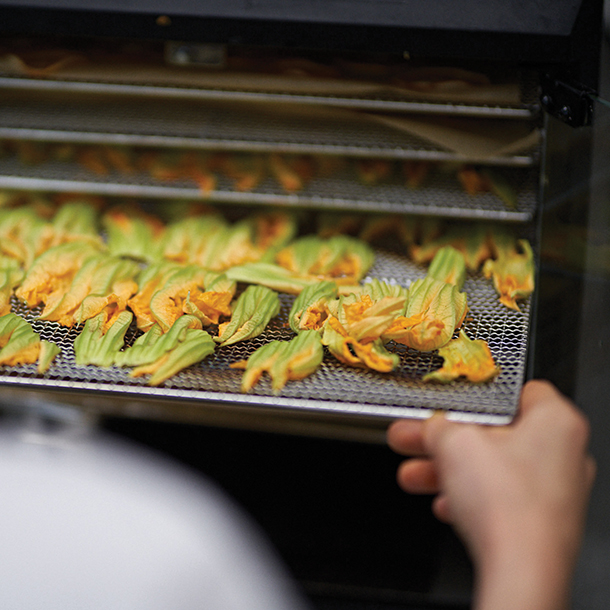
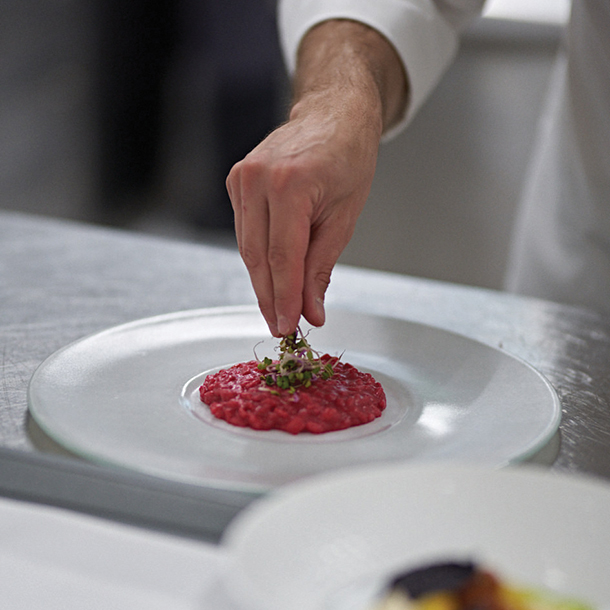
For Chenot Palace Weggis (chenotpalaceweggis.com), a wellness retreat in the heart of the Swiss Alps, plant-based eating is a central pillar in a weeklong detoxification process that essentially clears the rust from the battery that is the human body. For seven days straight, guests are served different plant-based menus designed by Executive Chef Ettore Moliteo. The food is beautiful, and staring at it you’d have no idea that it is pointedly missing proteins and amino acids. It’s a fast-mimicking diet without the juice-cleanse deprivation feeling.
“We aren’t promoting just plant-based diets. We are in support of having a variety of foods including animal protein,” says Dr. George Gaitanos, Chenot’s chief operating and scientific director. “But we know this [plant-based detox] is a fantastic medicine, the best thing you can do for your body together with exercise.”
In October, Chenot will release a cookbook featuring 184 recipes. The book will retail for $45, substantially lower than the $6,000 cost of doing the Chenot detox program in Switzerland, or the $1,000 cost of dinner for two at Eleven Madison Park. Vegetables have never looked so good and so different, and there’s a price to pay for it.
Ask Chef Eyal Shani, who made headlines for the $24 single tomato he serves at his restaurant, Naked Tomato (nakedtomatonyc.com) in New York. He’ll fire back with a question of his own. “Three hundred meters west of us they sell the simplest T-shirt for $1,000. The cost to produce a tomato is the same as this T-shirt. So how is [our price] wrong?” After all, he rations, it’s about something far greater than even the vegetable itself. “It is eating the divine intention of the tomato and it cannot be measured.”
Photo credits: Courtesy of Eleven Madison Park, Ark, Sapid, and Chenot Palace Weggis




